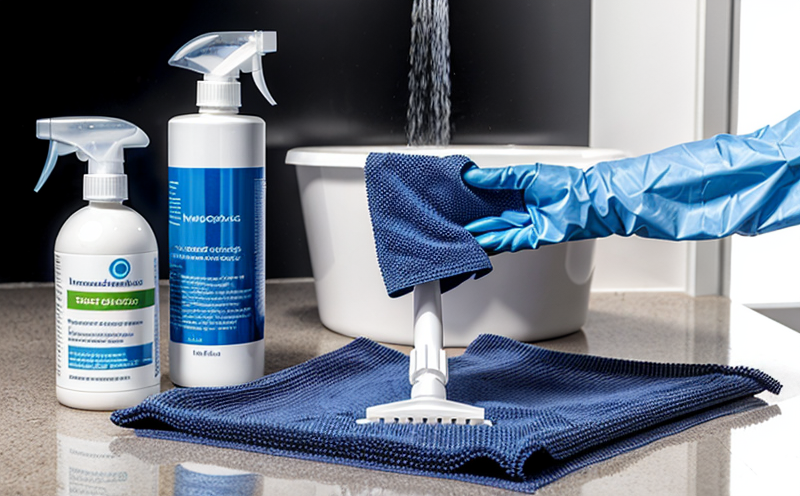ISO 10993 5 In Vitro Cytotoxicity Testing of Hygiene Products with Nanomaterials
The ISO 10993-5 standard is a critical component in the regulatory framework for medical devices and other contact materials used in healthcare. This standard specifically addresses the cytotoxic potential of materials, ensuring they do not cause adverse effects when in direct contact with human tissues.
When nanomaterials are incorporated into hygiene products such as soaps, sanitizers, and personal care items, their unique properties can enhance product efficacy but also introduce new challenges for safety evaluation. The ISO 10993-5 test is particularly relevant here because it assesses the cytotoxicity of materials that may come into contact with skin or mucous membranes.
The testing protocol requires exposure of a defined cell culture (typically Vero cells) to extracts, leachates, or other release products from the tested material. The duration and concentration of this exposure are specified in the standard. Following the incubation period, cytotoxicity is evaluated by assessing cellular viability using assays like MTT or Alamar Blue.
This testing method ensures that nanomaterials incorporated into hygiene products do not cause significant cellular damage, which could lead to irritation, inflammation, or other adverse reactions upon use. The results of this test are crucial for obtaining regulatory approvals and ensuring the safety of end-users.
The cytotoxicity test is just one part of a comprehensive testing regimen that might include biocompatibility assessments under ISO 10993-1, allergenicity testing as per ISO 14918, or other relevant standards. Together, these tests provide a holistic evaluation of the safety profile of nanomaterials in hygiene products.
Understanding the behavior and potential risks associated with nanomaterials is essential for both product developers and regulatory bodies. By adhering to international standards like ISO 10993-5, manufacturers can ensure their products meet stringent safety requirements while maintaining efficacy and consumer trust.
| Test Specimen | Incubation Time | Cytotoxicity Assay Method | Cell Line Used |
|---|---|---|---|
| Nanomaterial-containing hygiene product extracts or leachates | 5 days at 37°C | MTT assay | Vero cells |
The table above outlines the typical parameters for an ISO 10993-5 test. The choice of cell line (Vero cells) and cytotoxicity assay method (MTT) are standard across this testing protocol, ensuring consistency and comparability in results.
In summary, the ISO 10993-5 cytotoxicity test is a cornerstone of nanomaterial safety evaluation. It provides critical data to ensure that products incorporating these advanced materials do not pose risks to human health. This test is especially important for hygiene products where prolonged or frequent contact with skin and mucous membranes can occur.
Industry Applications
- Skin care products containing nano-silver particles
- Antimicrobial soaps and hand sanitizers using nanomaterials
- Hygiene wipes with embedded nanoparticles for enhanced cleaning efficacy
| Product Category | Nanomaterial Type | Potential Benefits | Regulatory Considerations |
|---|---|---|---|
| Skin care products | Nano-silver particles | Antibacterial, anti-inflammatory properties | Cytotoxicity testing required per ISO 10993-5 |
| Antimicrobial soaps | ZnO nanoparticles | Broad spectrum antimicrobial activity | Biocompatibility and cytotoxicity tests required |
| Hypoallergenic wipes | Copper-based nanomaterials | Enhanced efficacy in removing pathogens | Allergenicity testing recommended per ISO 14918 |
The table above highlights various hygiene products that incorporate nanomaterials and the associated regulatory requirements. Each product type faces unique challenges, particularly concerning biocompatibility and potential cytotoxic effects.
For instance, skin care products containing nano-silver particles benefit from their antibacterial properties but must undergo rigorous testing to ensure they do not cause cellular damage or irritation. Similarly, antimicrobial soaps with ZnO nanoparticles need thorough evaluation of both biocompatibility and allergenicity.
The regulatory landscape for nanomaterials is continually evolving, with agencies like the FDA, ECHA, and others issuing guidelines and standards to ensure public safety. Compliance with these regulations requires meticulous attention to detail in product development and testing.
Eurolab Advantages
At Eurolab, we pride ourselves on offering cutting-edge services that meet the highest international standards. Our team of experts is well-versed in nanomaterials testing and can provide tailored solutions to ensure compliance with ISO 10993-5.
We offer several advantages over other laboratories:
- Experienced Specialists: Our staff includes scientists with extensive experience in nanotechnology, biocompatibility assessments, and regulatory affairs.
- State-of-the-Art Facilities: We are equipped with the latest analytical instruments to perform precise measurements and evaluations of nanomaterials.
- Comprehensive Testing Solutions: In addition to ISO 10993-5 cytotoxicity testing, we provide a full suite of biocompatibility tests under ISO 10993 standards.
- Dedicated Reporting: Our reports are detailed and comprehensive, providing actionable insights for product development and regulatory submissions.
- Custom Solutions: We can design testing protocols specifically tailored to the unique properties of your nanomaterials.
- Compliance Support: Our team can assist with navigating complex regulations and provide guidance on compliance strategies.
By leveraging our expertise, you can ensure that your products incorporating nanomaterials meet all necessary safety standards and regulatory requirements. Contact us today to learn more about how Eurolab can support your testing needs.
Competitive Advantage and Market Impact
Incorporating nanomaterials into hygiene products can offer significant competitive advantages. These materials enhance product efficacy, reduce manufacturing costs, and improve sustainability. However, the regulatory landscape is stringent, requiring thorough testing to ensure safety.
By adhering to international standards like ISO 10993-5, manufacturers demonstrate their commitment to consumer safety. This not only builds trust with end-users but also opens doors to new markets where regulatory compliance is a priority.
The cytotoxicity test is just one step in ensuring the overall biocompatibility of nanomaterials. By conducting comprehensive testing under ISO 10993 standards, companies can differentiate themselves from competitors who may not meet these stringent requirements. This commitment to safety and quality can lead to increased market share and brand loyalty.
Moreover, compliance with international standards can facilitate smoother entry into global markets where regulatory barriers are high. The ability to provide detailed, compliant reports is a key differentiator in today's competitive landscape.





